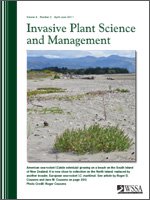Rehabilitation of downy brome–infested shrublands is challenging once this invasive grass dominates native communities. The effectiveness of imazapic herbicide in reducing downy brome cover has been variable, and there is uncertainty about the impacts of imazapic on native species. We used a before-after-control-impact (BACI) field experiment and greenhouse studies to (1) determine if imazapic herbicide applied at 132 g ai ha−1 (8 oz/ac−1) and seeding with two native shrub species (Wyoming big sagebrush [Artemisia tridentata] and Mexican cliffrose [Purshia mexicana]) reduced downy brome cover and promoted shrub establishment, (2) assess potential effects of imazapic on nontarget plant species and plant community composition, and (3) determine if imazapic affected downy brome or seeded shrub species when applied at different developmental stages. Seeding shrubs, alone, or in combination with imazapic application, did not significantly increase shrub density, possibly because of droughty conditions. In the field, imazapic reduced downy brome cover by 20% and nontarget forb cover by 25% and altered plant community composition the first year after treatment. Imazapic was lethal to downy brome at all growth stages in the greenhouse and reduced shrub germination by 50 to 80%, but older shrub seedlings were more tolerant of the herbicide. We conclude that a one-time application of imazapic combined with seeding shrubs was only slightly effective in rehabilitating areas with high downy brome and thatch cover and resulted in short-term impacts to nontarget species. These results highlight the need to treat downy brome infestations before they become too large. Also, removing thatch prior to treating with imazapic, although likely lethal to the native shrubs we studied, could increase the effectiveness of imazapic.
Nomenclature: Imazapic; downy brome, Bromus tectorum L.; Mexican cliffrose, Purshia mexicana (D. Don) Henrickson; Wyoming big sagebrush, Artemisia tridentata Nutt. ssp. wyomingensis Beetle & Young. Nomenclature of all plants follows the USDA-NRCS PLANTS database ( http://plants.usda.gov/), and common names of invasive plant species follow the WSSA database ( http://www.wssa.net/Weeds/ID/WeedNames/namesearch.php).
Interpretive Summary: Downy brome is a highly invasive annual grass that can outcompete native plant species and increase the frequency of fires. We examined if treatment with imazapic herbicide and/or seeding with native shrubs was effective in rehabilitating shrublands highly invaded by downy brome. We also determined the effects of imazapic on different growth stages of both downy brome and three shrub species in the greenhouse. Imazapic was lethal to downy brome at all growth stages in the greenhouse, yet only reduced downy brome cover by 20% for one season in the field, likely due to high thatch cover and the large amount of available downy brome seeds. Imazapic also altered plant community composition and reduced forb cover by 25% in the field the first year after treatment. Shrub establishment was low in all seeding treatments, probably because of droughty conditions. Shrub germination was reduced in the greenhouse by up to 80% by imazapic, yet remnant shrubs in the field and 4-mo-old shrubs in the greenhouse were tolerant of the herbicide, leading us to recommend that imazapic be applied after shrubs are established instead of at the time of seeding. We conclude that a one-time imazapic application and seeding treatment was minimally effective in reducing downy brome or increasing shrub density, but fortunately, the disturbances associated wi





